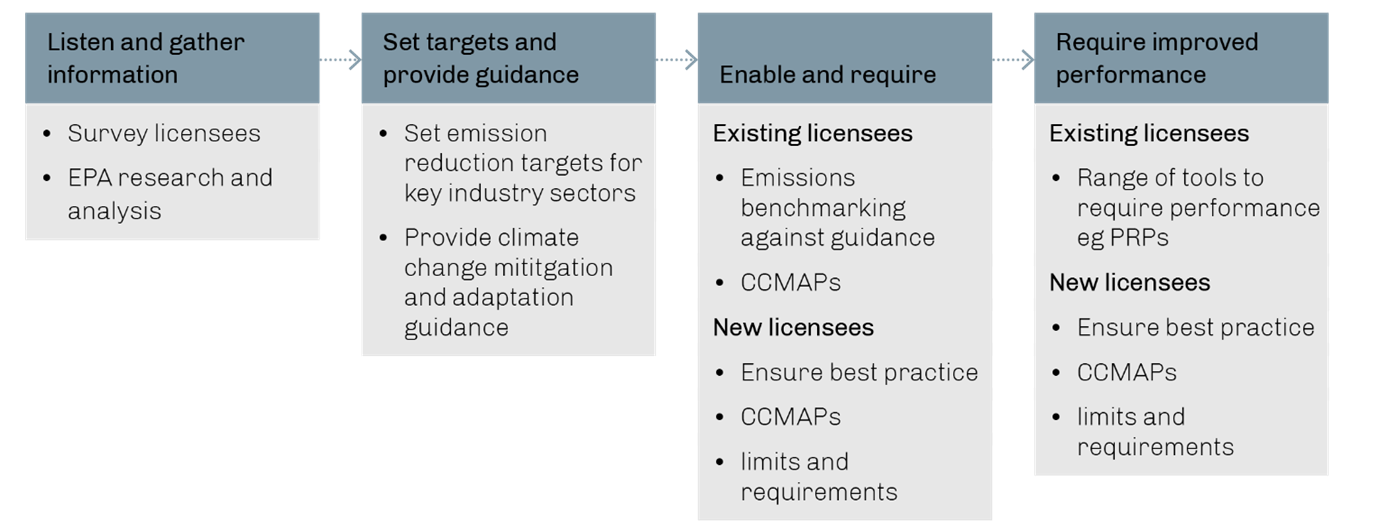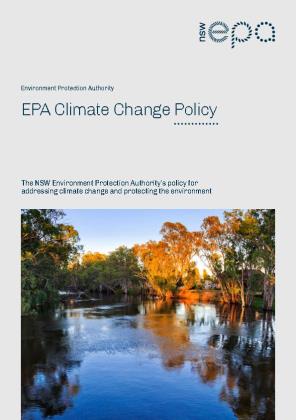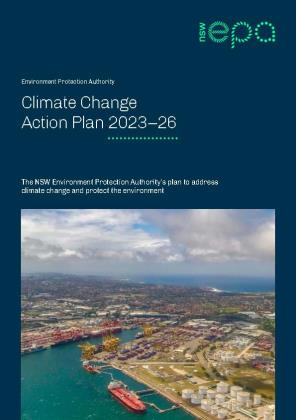Our climate change policy and action plan
The EPA has a critical role in protecting the environment from the threat of climate change and in delivering actions that will support NSW to achieve net zero emissions by 2050.
Our Climate Change Policy and Climate Change Action Plan 2023–26 outline a comprehensive regulatory approach and set of actions to address the causes and consequences of climate change in NSW. They support and build on the NSW Government’s climate change policies and initiatives, helping industry to decarbonise and build greater preparedness and resilience to climate change risks.
Our focus is on enabling and supporting best practice and building collaborative processes to ensure any actions we take are meaningful, feasible and cost-effective.
Public consultation on our draft policy and action plan
In 2022, we consulted on a draft climate change policy and action plan. For information on the consultation process, including a summary of the submissions we received and how we responded, please visit our Your Say page.
Climate Change Policy
Our Climate Change Policy (PDF 4.8MB) describes the causes and consequences of climate change in NSW and outlines our commitment to deliver on our statutory objectives and duty to address climate change and our Strategic Plan 2021–24 commitments.
Our policy adopts, supports and builds on the NSW Government’s overarching climate change objectives, which include reducing greenhouse gas emissions and making NSW more resilient and adapted to a changing climate. The policy also gives our stakeholders certainty on our climate change regulatory approach.
Climate Change Policy (PDF 4.8MB)
Climate Change Action Plan 2023–26
Our Climate Change Action Plan 2023–26 (PDF 6MB) describes how we’ll deliver on the objectives of our policy. It outlines the specific actions we’ll take over the next three years, as part of our evolving regulatory response to climate change.
Our action plan also signals the stronger regulatory action we intend to take over the medium- to longer-term, if an increased regulatory response is required to support the NSW Government’s climate change actions and commitments, including achieving net zero emissions in NSW by 2050.
Climate Change Action Plan 2023-26 (PDF 6MB)
Industry-sector advisory groups
Critical to the success of our action plan, is our investment in working with industry, other government agencies and the community at every step, so that we’re all on the same path working towards the same goal. To facilitate this, we are establishing industry-sector advisory groups to help inform and co-design our industry-specific climate change actions.
These advisory groups will provide us with valuable information on potential options, gaps, risks and opportunities, as we design and progress these actions. We’ll invite a broad range of representatives to form these advisory groups, including representatives from industry, government and the community, and experts with relevant knowledge of the sector in question.
Fact sheets, frequently asked questions and other information
We have prepared a series of fact sheets, answers to frequently asked questions, and other information, to help the community and industry better understand our climate change policy and action plan.
Other EPA initiatives and commitments on climate change
Learn about other ways we contribute to the NSW Government’s Climate Change Policy Framework goals of reducing greenhouse gas emissions and increasing resilience to climate change.
Download
EPA Climate Change Policy
The NSW Environment Protection Authority’s policy for addressing climate change and protecting the environment
Download
Climate Change Action Plan 2023-26
The NSW Environment Protection Authority’s plan to address climate change and protect the environment
Inform and plan: continually improving as we listen, provide support and report
- Reliable, high-quality information and planning are critical for an effective climate change response. ‘Information and planning’ includes determining baselines, assessing risks, promoting good practices, measuring success, reporting in a transparent way, and improving in response to new evidence, technologies, government policies and stakeholder feedback.
Mitigate: reducing greenhouse gas emissions
- Climate change mitigation is about taking action to reduce the rate of climate change. It includes actions that limit or prevent greenhouse gas emissions and activities that remove these gases from the atmosphere.
Adapt: adapting and building resilience to a changing climate
- Climate change adaptation is about adjusting to the actual or expected effects of climate change. Adaptation plays a key role in reducing exposure and vulnerability to climate change. Adaptation enables communities, business and the economy to plan for, and recover more quickly and easily from, the acute and chronic impacts of climate change.
The climate change action plan commits us to a series of progressive actions that are deliberate, systematic, well informed and appropriately paced. They are summarised below. Visit climate change initiatives and commitments to find out what else we are doing to respond to climate change.
Inform and plan actions
- Action 1: Monitor and report on the impacts of climate change, greenhouse gas emissions and the implementation and effectiveness of the NSW Net Zero Plan, in NSW State of the Environment reports
- Action 2: Engage and collaborate with climate change experts across the NSW Government, and with other jurisdictions, as the EPA develops and implements its climate change actions
- Action 3: Monitor emerging issues, trends, risks and opportunities surrounding the issue of climate change and the transition to a decarbonised economy
- Action 4: Support EPA officers to make climate-change-related decisions
- Action 5: Require and support our regulated community to develop and implement plans to minimise emissions and exposure to climate risks
- Action 5(a): Focus our regulatory effort by first listening to our regulated community, so we understand the climate change actions already being taken
- Action 5(b): Progressively require and support our licensees to prepare, implement and report on climate change mitigation and adaptation plans
- Action 5(c): Partner with DPE to seek to ensure climate change is being adequately addressed by proponents of activities we’ll regulate, and that approvals contain appropriate conditions
- Action 5(d): Require and support all our licensees to specifically consider how a changing climate might increase their risk of pollution incidents, and require them to update their pollution incident response management plans accordingly
- Action 6: Listen to and learn from Aboriginal people; create opportunities to meaningfully engage and receive feedback on our climate change response
- Action 7: Regularly discuss our climate change approach with the EPA’s Environment Youth Advisory Council, to ensure we’re putting intergenerational equity into practice
- Action 8: Prepare an annual EPA statement on climate change impacts, risks and adaptation to better understand and prepare for the impacts of climate change on our operations
- Action 9: Report on the progress of our action plan in our Annual Report
Mitigate actions
- Action 10: Develop and implement programs to reduce greenhouse gas emissions from the waste sector, including our target of net zero emissions from organic waste from landfills by 2030
- Action 11: Support the whole-of-government approach to streamlining project approvals in renewable energy zones
- Action 12: Develop and implement tailored behavioural change programs to encourage and enable greenhouse gas emission reductions
- Action 13: Ensure methane emissions from EPA licensed onshore gas operators are minimised; review existing leak detection and repair programs
- Action 14: Regulate short-lived climate pollutants from our licensees
- Action 15: Lead by example, maintaining efforts to become a carbon-neutral organisation by 2030
- Action 16: Develop a series of greenhouse gas emission reduction targets and related pathways for key industry sectors we license, to help guide our regulatory effort
- Action 17: Prepare or adopt climate change mitigation guidance for key industry sectors we license, including the performance outcomes we seek
- Action 18: Progressively place greenhouse gas emission limits and other requirements on licences for key industry sectors
- Action 19: Encourage and support our regulated community to innovate
Adapt actions
- Action 20: Protect the environment during emergency response and recovery, and strengthen our approach by being better prepared for the impacts of climate change
- Action 21: Ensure climate risks are considered in native forestry via the Forest Monitoring and Improvement Program
- Action 22: Develop an adaptation and resilience delivery plan for the EPA
- Action 23: Develop and implement environmental resilience programs and initiatives
- Action 24: Prepare or adopt climate change adaptation guidance for key industry sectors we license, including the performance outcomes we seek
- Action 25: Develop a climate change citizen-science strategy and community education program to encourage and support young people to make observations about changes in their local environment
How our actions will be staged
Our climate change actions will be staged, progressive and iterative – allowing time for licensees to adjust and for data to inform what actions must be taken and where.

Note:
- CCMAPs = climate change mitigation and adaptation plans
- PRPs = pollution reduction programs



